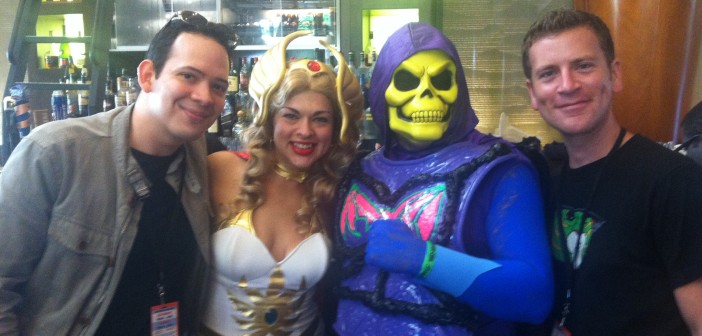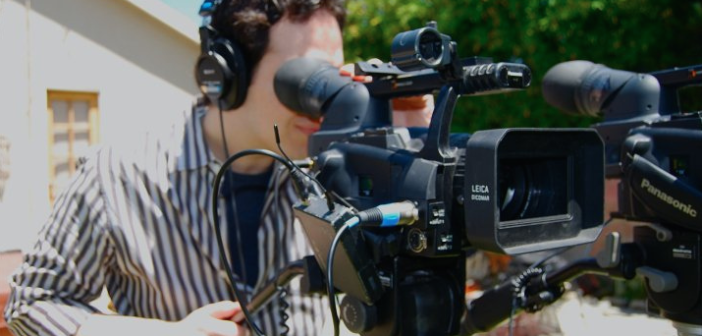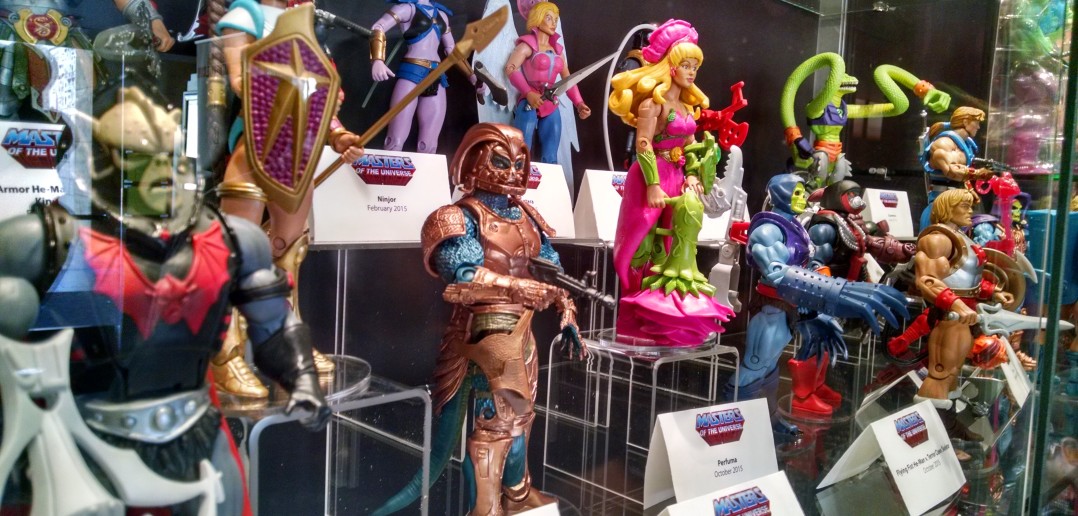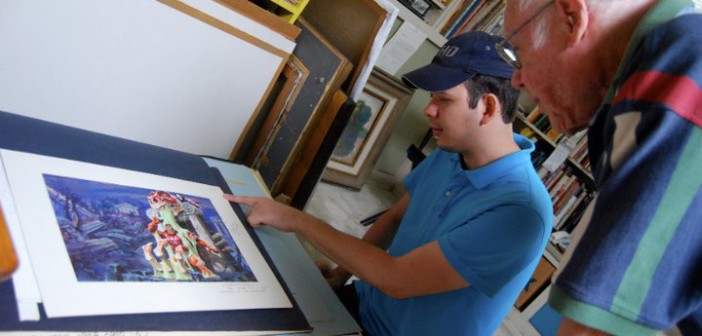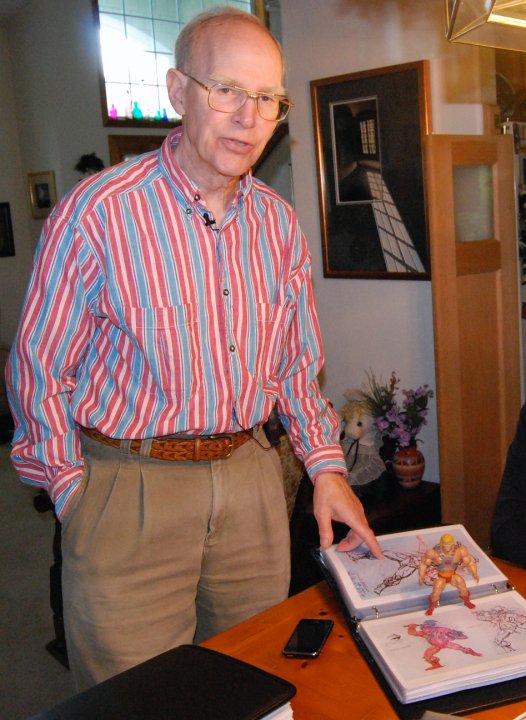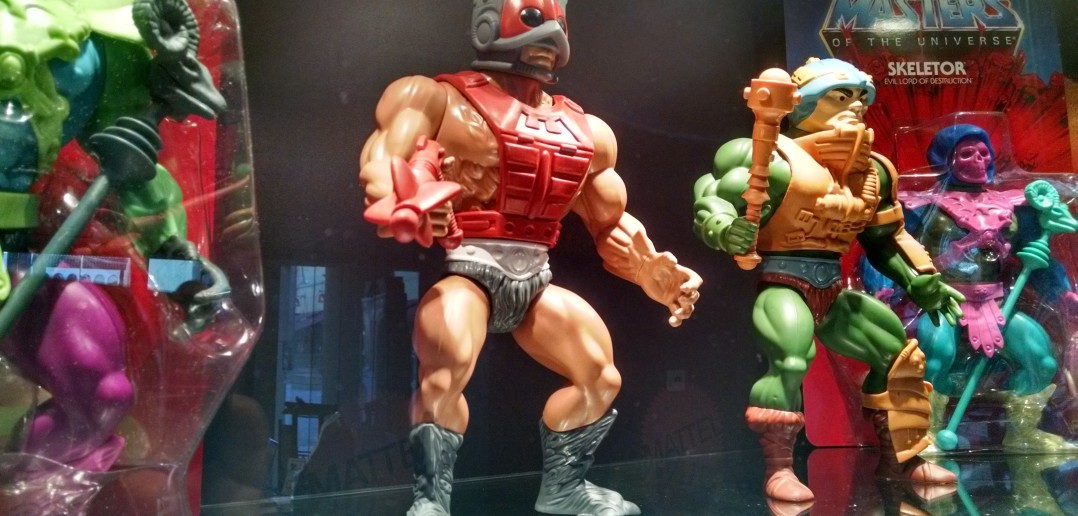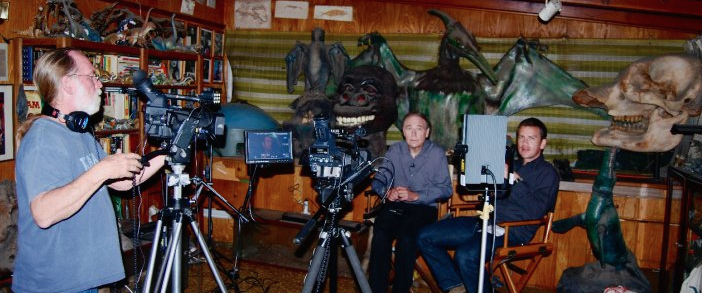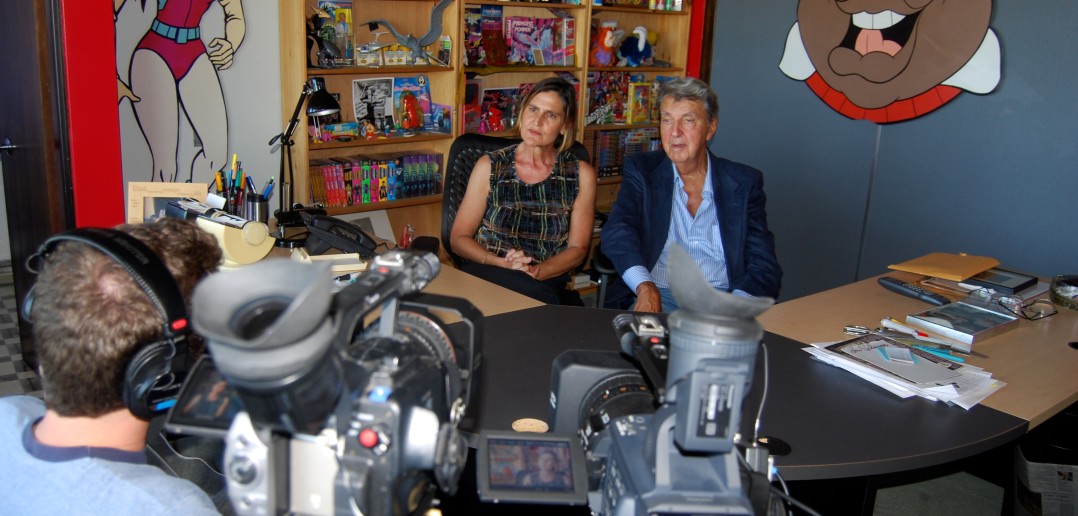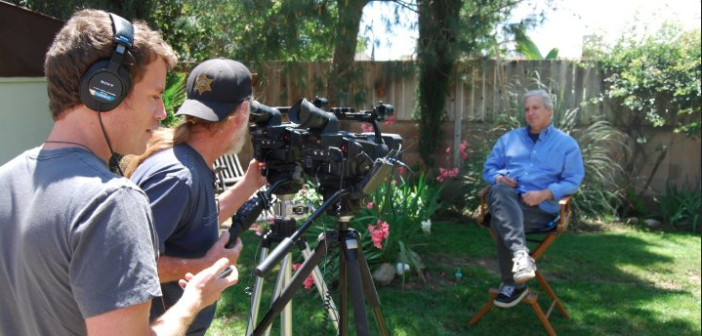10 Secrets From the Directors of the He-Man Documentary Toy Masters
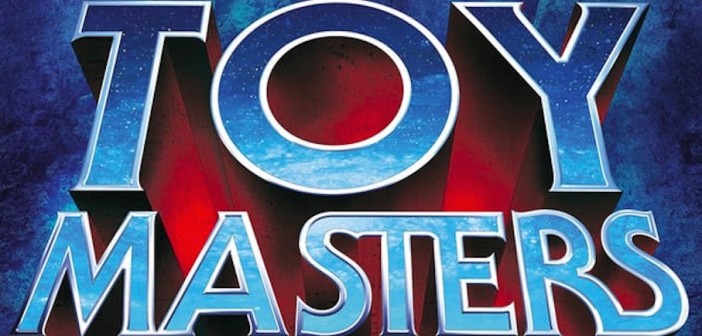
Let’s face it: the first time you or I tore open the package of a Battle Armor He-Man action figure, we weren’t wondering who designed it. We were too busy thinking: “This is the coolest thing I’ve ever seen!” But someone out there deserves the credit, and at least two former Mattel employees are claiming it for themselves. According to Preliminary Designer Roger Sweet, it was all his doing. But Visual Designer Mark Taylor insists that he’s the one who created the character. Fascinated by the story, filmmakers Corey Landis and Roger Lay Jr. interviewed dozens of artists and execs who worked on the Mattel franchise for their new documentary Toy Masters. At its West Coast premiere, presented by the American Cinematheque and Dammaged Goods, I spoke with Landis and Lay about He-Man’s controversial origin.
1. “I Want That!”
The Robot’s Voice: When was the first time you remember hearing the name He-Man?
Roger Lay Jr.: I was probably about three or four years old, I guess. Probably one of the first words I ever said.
Corey Landis: The first time I was aware of it was when I got a Man-E-Faces figure, because I was sick or something. A person from my church bought me Man-E-Faces to help me feel better.
Roger: How could someone from your church buy you an action figure that is demon possessed?!
Corey: Yeah, I know, right?
Roger: That makes no sense!
Corey: They knew I was sick, so they probably thought ‘What can I get this kid?’ Anyway, I ended up with a cool action figure! And then I gradually discovered the rest of the toys. Once the TV show came on, I was a goner! That was it!
Roger: The artwork on the packaging was key. I remember going to the store and seeing the packaging and thinking ‘I want that!’
TRV: You mentioned Man-E-Faces. Were there other figures that struck you as particularly cool at the time?
Roger: Thunder Punch He-Man! I loved that figure, because you’d open his back and put a cap inside, and you’d do the twist-action that all the figures had, but when you’d release, the punch triggered the cap and it would sound like an explosion! I loved that one. These were artifacts that I was really into when I was four or five years old. I’d just stare at them and my mind would race away. I came up with these bizarre fantasy scenarios, and now that I’m a filmmaker and a storyteller, I realize that the earliest stories I crafted were based on the He-Man action figures. I built an entire mythology in my head, before ever seeing the show. Which is weird, but that’s what a good toy is supposed to do, right?
Corey: It’s all about the toys. I mean, the show was the hook, because you watched it every day in your house, but the toys were the coolest. That was the thing that got you.
Roger: Design-wise, they were incredible.
Corey: I had a… I forget what it was called… Can’t remember the official name… It was a tiny playset…
Roger: The Fright Zone?
Corey: Yeah! Fright Zone! You’d put your hand in the snake puppet! I thought it was the coolest thing, because you could grab the figures and pull them inside the hole!
Roger: It had those trees that would clamp the figures.
Corey: And the slime pit!
TRV: That’s what always separated the He-Man toys from the Star Wars figures. They had much more functionality!
Corey: They were interactive.
Roger: The Star Wars figures were almost delicate in a way, and when you’re a tiny kid, you want to play with something bigger! The size empowers you, and that’s the point, because you have no power when you’re a kid.
2. The Rollercoaster Ride
https://vimeo.com/137438409
TRV: So when did you get the idea to start investigating who created He-Man?
Corey: Well, I’d never even thought about it until Roger mentioned it when we were working together on some other stuff. We were talking about all the things we loved as kids, and He-Man came up, and we started a whole dialog about that.
Roger: He had no idea about Mark Taylor or Roger Sweet. I’d read the Tomart Action Figure Digest articles that Mark had written. I’d read Roger’s book Mastering the Universe. I’d read Michael Halperin’s bible for the show, that had all the original ideas. I was the kind of fan who wanted to know the answers to things. So I remember telling Corey all that stuff and he was like ‘What?!’
Corey: Yeah, Roger loaned me the book, and even though it was extremely one-sided, I thought it was such a great story! From there it became a conversation about what we should do with this information.
Roger: It was weird to me that no one had taken it upon themselves to find these people and explore the story on film. Because there’s been documentaries on anything and everything, and this means something to our generation. So eventually we just decided to contact these people ourselves and see if they’d talk to us. We didn’t know if anyone would call us back. Interestingly enough, Roger Sweet was one of the first ones we reached out to, and he said ‘Yes! I’ll talk to you guys!’
Corey: Once we started reaching out to people, and getting responses, that’s when I realized we were really going to do it. And every single person we interviewed was fascinating. I always left thinking ‘I can’t believe we got so lucky!’
Roger: You’ll see that happen in the documentary. We’d drive away from an interview and say ‘That’s it! That’s the answer to how He-Man was created!’ And then we’d do another interview three days later and go ‘No! That’s not how it happened!’ It was like a rollercoaster ride. And in the movie, we take the viewer on that same journey and leave it up to them to decide who really did what. It took a long time to figure out how to craft that narrative and make it compelling.
3. Missing Dolph
TRV: Was there anyone involved in the creation of He-Man that you wanted to speak with, but weren’t able to make it happen?
Roger: Yes, but no one really major. I mean, without Mark Taylor or Roger Sweet that would have crippled our efforts. But there were a few ancillary figures that we would have loved to include. Dolph Lundgren, of course.
Corey: We came close to getting him.
Roger: We were close to having Dolph in the film, but schedule-wise it just didn’t work out. More importantly, there were Mattel employees at the time we were making the film that were not allowed to talk to us. The company wouldn’t allow it.
TRV: A month ago, I interviewed the director of a new documentary called Doomed, about Roger Corman’s Fantastic Four movie. There’s also been a recent documentary about Tim Burton’s Superman film. Now there’s Toy Masters. What’s the reason for so many geek-centric docs coming out all of a sudden?
Roger: We’re all nostalgic. We’re getting older and we’re nostalgic for our long gone youth.
Corey: We’re also getting to the age when we’re actually making stuff. When you’re a fan, you just want to keep that feeling going. And making documentaries is one way to do that. But it’s weird. I mean, think about our parents going to a convention, in a room full of similarly aged people, and watching a bunch of old toy commercials from when they were younger. It’s absurd! And so, for whatever reason, this is very specific to who we are as adults right now. And since we’re creative people, and we’re able to make films, now we can do something about it.
4. Mattel Pleads the Fifth
TRV: You mentioned Mattel earlier. What’s their official stance on the film?
Roger: I don’t know! We couldn’t ask them.
Robot’s Voice: That’s very similar to the reaction the director of Doomed got from Marvel. They refuse to acknowledge his film, even though they’re aware it exists. Disney took the same hands-off approach with the movie Escape from Tomorrow.
Corey: Same thing with us.
Roger: Yes, because if they tried to prevent it, the backlash would be horrific. For example, we approached Scott Neitlich, who managed the Masters of the Universe Classics toy line for many years. He had to turn us down when he was still an employee at Mattel. But the moment he left, he said ‘Now I can sit down and talk to you guys!’ So we have a wonderful sit-down interview with Scott, where he discusses the state of the franchise now.
Corey: But it was too late to include his interview in the movie.
Roger: Right, it’s not in the movie, but when we have a Blu-ray release it’ll be included in the special features.
Corey: We also wanted to talk to John Erwin, who voiced He-Man in the cartoons, but he turned us down.
TRV: Really? Why?
Corey: Yeah, it’s sad. He’s kind of a hermit now, and feels it’s disappointing when people see him as a normal guy. We also tried to contact Melendy Britt, who voiced She-Ra, but she was the only one who wanted to get paid, if I remember correctly.
Roger: That sounds right.
Corey: We contacted her and she pretended she was another person on the phone. I believe she was asking for money, either as herself or her alter ego. But no one was getting paid on this thing!
Roger: At that point we still didn’t know what we were going to do with the footage. We were paying for our own flights to go wherever these people were. During our time off we’d edit with the equipment I purchased.
Corey: There was a guy named Martin Arriola who worked at Mattel up until a couple of years ago. He was there during the early ’80s He-Man run, and was still there when we contacted him. He was a very cranky, cantankerous, interesting and funny guy. He was like ‘I wanna talk to you guys!’ and we said ‘Let’s do it!’ Next thing you know, he calls back and says ‘I just got a letter from Mattel, I can’t talk to anyone.’
Roger: And that same letter he got went out to all the other Mattel employees. And it’s interesting, because this documentary is a ninety minute celebration of a product that Mattel controls. It makes perfect sense for us to somehow come together, but it hasn’t happened yet.
5. Finding the Right Structure
TRV: You both feature prominently in the documentary, since the story is told at times through your own eyes. Did you ever consider making a version where you took more of a backseat approach?
Roger: That was the initial idea. We ended up sticking ourselves in it because we had no choice. The way we were interacting with the people we interviewed, especially Roger Sweet, it just became too difficult to remove ourselves from it. Personally, I don’t want anyone to hear me, see me, or know me. I’d rather focus on the subject we’re exploring. But we’d find ourselves in the editing going ‘If we pull that piece with us out, we’re gonna lose some really valuable insight.’
Corey: Once we started looking at the thing, we realized that we were the thread that tied it all together.
Roger: Then we showed it to some people who felt that was the strength of it. They thought it was interesting that two guys who grew up loving this toy would spend four years of their lives doing this. To them, it was fascinating. So we became the surrogate for the audience.
Corey: It’s sad that we’re the most normal people in the film. If we’re the things that ground it, that’s frightening.
TRV: Was there anything unusual about the creation of He-Man that took you by surprise?
Corey: Tons of things.
Roger: What surprised us the most wasn’t so much the creation of the character. It was the demise of the franchise, and why it ended.
Corey: And how quickly it did.
Roger: Corporate politics and corporate mentality hastened the end of it. We were just sitting there, listening to these stories and wondering how they could let that happen. You’ll see that in the movie, and you’ll find out why it ended the way it did.
Corey: The biggest surprises we found weren’t the details about the toys. It was the behind-the-scenes picture of what went on at Mattel. That was the stuff that truly amazed us.
6. Meeting Roger
TRV: Roger Sweet, one of the main subjects of your film, comes across as a fascinating character. What did you think of him when you first met, and where do things currently stand with him today?
Corey: The first time we met Roger was when we flew to Seattle, and he answered the door wearing just a towel.
Roger: He was all wet! And kind of naked.
Corey: And he says (a spot-on Roger Sweet impression) “Hold on a second, I’ll be right back.” So we looked at each other and realized we were getting into something major here. We hung out with him for a few days. Went out to eat with him a bunch of times, and talked for hours. We loved him!
Roger: He was like a long lost relative that you get to see every few years, and the weekend you spend together is priceless because you know you’ll be telling these stories for the next ten years!
Corey: Really entertaining. Really welcoming.
Roger: Very likable! He was very nice to us, very sweet. So it was heartbreaking for us, because we had this vision of helping him reconnect with the world. We thought we’d get Roger to come out to an anniversary screening of Masters of the Universe, and stand in front of a group of people who adore what he helped to create. Then, maybe, all of this bullshit controversy could go away.
Corey: And we also thought, naively, that it we could get Roger, Mark Taylor and some of the others to sit down together, then maybe some kind of understanding could be reached.
Roger: That was our overall idea, and we worked very hard to make it happen.
Corey: But things went wrong once he saw the extended trailer we put out.
Roger: Even before that, we spent time with Roger in Los Angeles at his brother’s house, several months after our first interview. The problem was, he wouldn’t sign the release for the film. And it got to the point where we were confronting him on camera saying “Roger! What is the problem? Why aren’t you signing the release?” Even his brother was telling him to sign the damn release! And he kept saying “I got a lot of things to take into consideration.” We told him that we can’t make the movie if we have to cut him out. So finally, after all that, he signed it! Then we were invited to show an extended preview at the San Diego Comic-Con. So we put it all together and showed it, and the story got picked up everywhere. And Roger finds out about it. So he calls us and says that he saw the trailer, and he’s upset that it makes it look like both he and Mark Taylor had something to do with He-Man. And I said, “Yes, Roger, because both of you did.” So then he demanded to be in on the editing. And we said “No, you can’t edit the film.” That exact moment is in the movie, by the way. As documentarians, we just couldn’t allow the subject to be involved in the editing. It would ruin the integrity of the film! So in his mind, we backstabbed him.
Corey: He thought that we were there to tell his story. But the entire time we told him that we were also talking to Mark Taylor. We got along great with him, we were friendly, and then all of a sudden he sees the trailer and it wrecked him. So ultimately, he stopped talking to us. I’ve tried to email him since then, just to be neutral and friendly, but I’ve gotten nothing back.
Roger: It’s heartbreaking because we liked the guy very much. I mean, he had his quirks and a very unique perspective. But from a person to person standpoint, he was lovely to us. It’s kind of sad that we can’t reach out to him anymore now that the film is done.
Corey: To this day, he pushes everyone away, because he’s got such a narrow view of the way things happened. I mean, just take a look at Mark Taylor. You can’t help but love the guy. He lets everybody in!
7. A Universal Story
TRV: What do you hope He-Man fans will take away from this documentary?
Corey: I hope they’ll see it as a scrapbook of an era. But I hope they recognize that this isn’t just a documentary about toys. This is a documentary about creative people working at a very specific time in history, and the battle between consumerism and creatively, corporate culture, egos… It’s about everything. That’s what I hope He-Man fans will come away with.
Roger: There are moments in it that are very geeky. Certain things will be great trivia for He-Man fans. But as filmmakers and storytellers, we had to craft a narrative that everyone would find interesting. It has to work on a basic human interest level. There are larger themes that we had to develop and explore for the movie to become universal.
Robot’s Voice: That reminds me of the documentary Anvil! The Story of Anvil. I’m not a heavy metal fan, but I still loved the movie and appreciated the filmmakers’ message.
Corey: Yeah! That’s it exactly!
Roger: Or like The King of Kong, you know? Even if you’re not a video game geek, you still find those two dudes interesting subjects. From a human perspective, it’s pretty compelling.
8. Bonus Features
TRV: Is there a lot of material you couldn’t fit in the finished movie?
Corey: There are many, many things we had to cut or remove, because the film has to drive and build. It’s like reaching critical mass, you know? Anything that didn’t help that purpose, we had to pull out. We had a twenty minute explanation of why they came up with She-Ra, Princess of Power. But we had to remove it completely. We had to remove the comic books and the live-action Power Tour stage show, too. But again, we saved all that stuff, and the moment we have a definitive release of the film on DVD or Blu-ray, all of it will be there as special features.
TRV: Documentaries often rely on archival material, but with Mattel being so hands-off, how did you handle that aspect of the film?
Roger: There’s a lot of archival stuff in there! There are documents in the film that I keep hearing we shouldn’t have, but we got them from Roger and Mark. It’s weird, because Mark and Roger feel that since they created these characters, these images and documents are their own private assets, you know what I mean? But Mattel’s corporate mentality says that everything they did between nine in the morning and five at night belongs to the company. So there are a lot of gray areas here. Whether that means we’ll have to somehow license these things from Mattel, we’ll have to wait and see.
Corey: But how do you license a memo?
TRV: What about vintage toy commercials?
Roger: We’ve got plenty of those.
Corey: That stuff is on YouTube.
Roger: We also got tapes from Mattel’s marketing chief.
Corey: We got stuff from fans, too. Fans that collected videos over the years. We’d ask people if they had any old commercials, and they’d send us DVDs.
9. The Scheimer Legacy
TRV: Were the Filmation people any easier to deal with than Mattel?
Corey: Oh, yeah!
Roger: Absolutely! Lou Scheimer, God rest his soul, was a complete joy. All of the Filmation people were a real pleasure to deal with.
Corey: Scheimer invited us into his home. We sat down and he was totally cool. Totally different. Mattel was this big monolith that we didn’t know where to begin with.
Roger: I think we have the last on-camera interview with Lou. He passed away last year, so I think this is his last interview, and you’ll see some of it in the movie. We also have a sit-down with Lou and his daughter Erika. We haven’t even touched that stuff yet. That’s another forty-five minutes of Lou and Erika, one on one. That’ll be its own great DVD featurette.
10. Coming Soon!
TRV: Your film is currently on the festival and convention circuit, but when do you think we’ll see some type of official release?
Roger: Next year. This thing will be out next year. Even if we have to drive around town, selling it out of our cars. If you had asked us that question a year ago, we didn’t have a finished film. Now we do! We still have to do a theatrical mix, color correction, all those things, but we can finish that in a week or two once we have distribution.
TRV: He-Man remains a beloved character, thirty-plus years after he was first created. What is it about his world that still captures people’s imagination?
Corey: It’s a combination of a lot of things. There’s a nostalgia element, of course, but there’s also something visceral and universal about that toy. Something made those figures immediately appealing right off the bat when they hit the shelves. It’s a moment that’s frozen in time forever.
Roger: The fact is, the original toy was a great pastiche of the Hero’s Journey. It captured all those things that make mythology so important. You combine that with beautiful designs and you’ve got something really special. One of the writers of the original Filmation show told us that when you’re a kid, you’re not in control of anything. You have no power. Your parents tell you what to do. Your teachers tell you what to do. So, with He-Man, all of a sudden you have a character who has power… and you control him! He’s in your hands! So the combination of all that at such an early age, it sticks with you. I mean, I went to USC Film School. I studied all the greats, Kurosawa, Orson Welles… But none of them have the same emotional connection to me as He-Man. Those toys made me feel like I could be somebody, I could do something. Suddenly, my imagination became a vehicle to greater and bigger things. And if you’re able to generate that reaction in a four-year old or a five-year old, you’ve done something really special.
Previously by Matthew Chernov
12 Revelations From the Makers of Starchaser: The Legend of Orin in 3D
10 Secrets From the Cast and Crew of the ’80s Rambo Cartoon
10 Revelations From the New ‘He-Man’ Soundtrack Producers
10 Things We Learned From the 1986 Transformers Movie’s Original Cast and Crew

